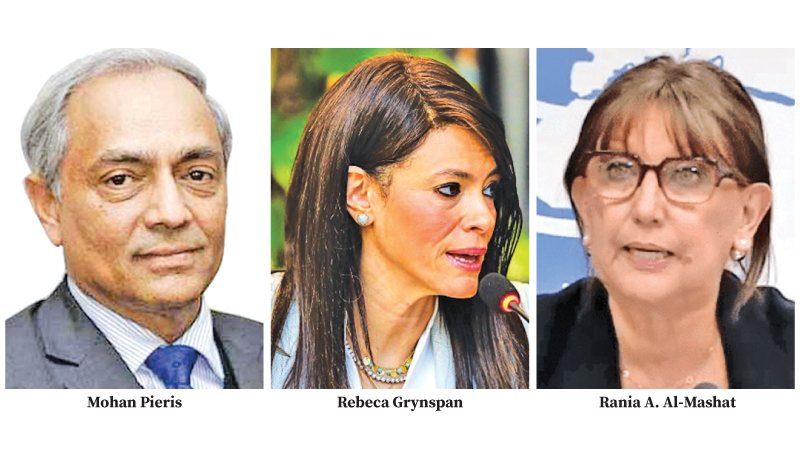As the world leaders converged to the United Nations (UN) headquarters in New York, late September, to adopt a historic Pact for the Future, conversations on rethinking debt and Debt Sustainability Analysis (DSA) took centre stage.
At the Summit of the Future, the groundbreaking pact and its annexes – Global Digital Compact and Declaration on Future — aimed to adapt the UN to the modern world and to address the needs of the future – were endorsed by the member states via a resolution made at the Summit of the Future, preceding the 79th session of the UN General Assembly.
Secretary-General of UNCTAD Rebeca Grynspan said serious conversations are needed when focusing on debt sustainability as it currently stands. Speaking on Debt Sustainability Analysis (DSAs), a tool used by the IMF to examine the ability of countries such as Sri Lanka to service their debt and assess the financing needs, she said that while DSAs are mostly measured in terms of capacity to pay, there is a need for the focus to be on sustainability instead. “Defaulting on your development, to not default on your debt, is the very contradiction of sustainability,” Grynspan said.
Debt servicing
Grynspan pointed to statistics indicating that more than two-thirds of the world’s developing countries experienced a deterioration in their external debt sustainability over the past six years, and in 2023, over 90 percent of all developing countries were paying more to service their debt as a percentage of their export earnings than the five percent limit set. This means that almost all developing countries, home to billions of people, are today spending more than triple on debt servicing, than what was deemed acceptable – with Governments and families being forced to make impossible decisions, she said.
“Around 3.3 billion people live in countries that today spend more on debt service than on either health or education, and due to the Covid-19 pandemic, debts and rising interest rates, debt service payment of developing countries reached $850 billion last year,” she added.
Speaking at the same conference, Economist and Minister of Planning and Economic Development of Egypt Rania A. Al-Mashat said that while DSAs are important tools, they are currently very rigid” and do not distinguish between the types of debt.
However, she believes that to foster sustainable economic growth, DSAs need to be more flexible tools.
“Particularly in the context of developing countries, there needs to be a more granular approach to looking at DSAs rather than just the type of debt, because that makes a huge difference when investors see whether a country is able to pay back or not,” she said. Al-Mashat said that some of the challenges lie in the economic assumption that “everything else is equal.” “But everything else is not equal”, she said. “You have pandemics, you have conflicts.”
These conflicts have repercussions on emerging economies way beyond the borders of where the financial awards are being increased, which means when these countries try to move forward, the domestic resources are never enough, with a gap that needs to be filled by financing, or by different sources of funding.
However, the economic reforms needed to overcome this gap also comes with more fiscal austerity, and that has implications on the people, she said.
Govt’s commitment
Revisiting Sri Lanka’s DSA under the country’s ongoing program was one of the proposals under the elections manifesto of the country’s newly appointed President, Anura Kumara Dissanayake. Even in the very first international statement made by Sri Lanka, which was at the UN General Assembly last week, Ambassador Mohan Pieris emphasized on the newly appointed Government’s commitment to the framework of “international financial institutions” while ensuring measures to generate “greater resources for enhanced public expenditure and welfare to raise the living standards of the people.”
Pieris also emphasised the need for “comprehensive” reform of the global financial architecture adding that the current international debt resolution framework has failed to respond adequately and efficiently to contemporary challenges. This includes the dramatic change of the the global debt landscape particularly in the developing world, which is increasingly controlled by international bond markets and non Paris Club lenders.
“It is, therefore, time that we review the architecture’s traditional moorings,” Pieris said.
Grynspan said that ultimately, the debt and development crisis is a symptom of a larger systemic failure.
“It is a failure to use at scale all the tools at our disposal in the global financial system and to embrace the changes designed in a different era for a different world,” she said.
She also focused on the dialogue around cancellation of debt, saying that a mechanism for debt cancellation is needed when debt is “truly unsustainable”, although it must be in an exceptional case.
“But we must recognise when there are exceptional situations,” she said.
Grynspan also stressed the need for greater transparency and stronger international cooperation, to ensure developing countries retain the rightful share of resources in a way that the proceeds of crime and corruption are not allowed to flourish.
“Countries need to tackle illicit financial goals and tax evasion,” she said.
This could be achieved through increasing the lending capacity of multilateral development banks, mobilising and crowding-in private capital for sustainable development, by strengthening guarantee schemes and exploring innovative financing, and also improving the conditions for affordable and long term financing, she added.









